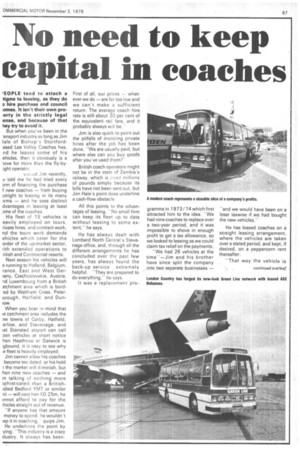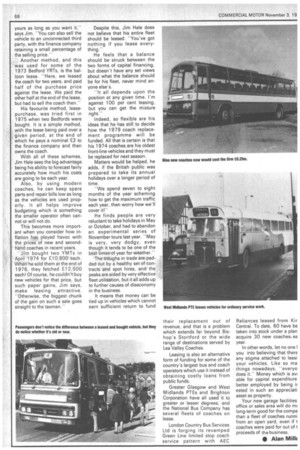No need to keep capital in coaches
Page 69

Page 70

If you've noticed an error in this article please click here to report it so we can fix it.
°E0PLE tend to attach a tigma to leasing, as they do D hire purchase and council lomes. It isn't their own proerty in the strictly legal ense, and because of that hey try to avoid it.
But when you've been in the -ansport industry as long as Jim lale of Bishop's Stortfordased Lea Valley Coaches has, nd he leases some of his ehicles, then it obviously is a love for more than the fly-byight operator.
visaed Jim recently,
e told me he had tried every )r-m of financing the purchase
f new coaches — from buying utright to leasing in its many )rms — and he sees distinct dvantages in leasing at least ame of the coaches.
His fleet of 18 vehicles is eavily employed an tours, rivate hires, and contract work, ri.d the tours work demands ehicles which cater for the order of the up-market sector, dth extended operations to ritish and Continental resorts.
Next season his vehicles will e running to Holland, Belgium, rance, East and West Gerlany, Czechoslovakia, Austria, ad Luxembourg from a British atchment area which is bord-ed by Waltham Cross, Peterorough, Hatfield, and Duntow.
When you bear in mind that le catchment area includes the Dvv towns of Corby, Hatfield, arlow, and Stevenage, and at Stansted airport can call
on vehicles at short notice hen Heathrow or Gatwick is igbound, it is easy to see why le fleet is heavily employed.
Jim cannot allow his coaches become too dated, or his hold the market will diminish, but hen nine new coaches — and m talking of nothing more )phisticated than a British)died Bedford YMT or similar it will cost him EO.25m, he innot afford to pay for the ;hides straight out of revenue.
'If anyone has that amount money to spend, he wouldn't ;ep it in coaching,'" quips Jim.
He underlines the point by ying: "This industry is a crazy dustry. It always has been. First of all, our prices -whatever we do — are far too low and we can't make a sufficient return. The average coach hire rate is still about 30 per cent of the equivalent rail fare, and it probably always will be."
Jim is also quick to point out the pitfalls of invoicing private hires after the job has been done. "We are usually paid, but where else can you buy goods after you've used them?"
British coach operators might not be in the state of Zambia's railway, which is owed trillions of pounds simply because its bills have not been sent out, but Jim Hale's point does underline a cash-flow obstacle.
All this points to the advantages of leasing. ''No small firm can keep its fleet up to date without leasing to some extent," he says.
He has always dealt with Lombard North Central's Stevenage office, and, through all the different arrangements he has concluded over the past few years, has always found the back-up service extremely helpful. "They are prepared to do everything," he says It was a replacement pro
gramme in 1973/74 which first attracted him to the idea. -We had nine coaches to replace over a two-year period, and it was impossible to shove in enough profit to get a tax allowance, so we looked to leasing as we could claim tax relief on the payments.
-We had 26 vehicles at the time"—Jim and his brother have since split the company into two separate businesses — -and we would have been on a loser taxwise if we had bought the new vehicles."
He has leased coaches on a straight leasing arrangement, where the vehicles are taken over a stated period, and kept, if desired, on a peppercorn rent thereafter, "That way the vehicle is yours as long as you want it," says Jim. "You can also sell the vehicle to an unconnected third party, with the finance company retaining a small percentage of the selling price."
Another method, and this was used for some of the 1973 Bedford YRTs, is the balloon lease. "Here, we leased the coach for two years, and paid half of the purchase price against the lease. We paid the other half at the end of the lease, but had to sell the coach then."
His favourite method, leasepurchase, was tried first in 1 975 when two Bedfords were bought. It is a simple method, with the lease being paid over a given period, at the end of which he pays a nominal £3 to the finance company and then owns the coach.
With all of these schemes, Jim Hale sees the big advantage being his ability to forecast fairly accurately how much his costs are going to be each year.
Also, by using modern coaches, he can keep spare parts and repair bills low as long as the vehicles are used properly. It all helps improve budgeting which is something the smaller operator often cannot or will not do.
This becomes more important when you consider how inflation has played havoc with the prices of new and secondhand coaches in recent years.
Jim bought two YMTs in April 1974 for £1 0,800 each. When he sold them at the end of 1976, they fetched £12,500 each! Of course, he couldn't buy new vehicles for that price, but such paper gains, Jim says, make leasing attractive. "Otherwise, the biggest chunk of the gain on such a sale goes straight to the taxman." Despite this, Jim Hale does not believe that his entire fleet should be leased: "You've got nothing if you lease everything."
He feels that a balance should be struck between the two forms of capital financing, but doesn't have any set views about what the balance should be for his fleet, never mind anyone else's.
"It all depends upon the position at any given time. I'm against 100 per cent leasing, but you can get the mixture right."
Indeed, so flexible are his ideas that he has still to decide how the 1979 coach replacement programme will be funded. All that is certain is that his 1974 coaches are his oldest front-line vehicles and they must be replaced for next season.
Matters would be helped, he adds, if the British public was prepared to take its annual holidays over a longer period of time.
"We spend seven to eight months of the year scheming how to get the maximum traffic each year, then worry how we'll cover it!"
He finds people are very reluctant to take holidays in May or October, and had to abandon an experimental series of November tours last year. -May is very, very dodgy, even though it tends to be one of the best times of year for weather."
The troughs in trade are padded out by a healthy set of contracts and spot hires, and the peaks are aided by very effective fleet utilisation, but it all adds up to further causes of diseconomy in the business.
It means that money can be tied up in vehicles which cannot earn sufficient return to fund their replacement out of revenue, and that is a problem which extends far beyond Bishop's Stortford or the wide range of destinations served by Lea Valley Coaches.
Leasing is also an alternative form of funding for some of the country's largest bus and coach operators which use it instead of obtaining costly loans from public funds.
Greater Glasgow and West Midlands PTEs and Brighton Corporation have all used it to greater or lesser degrees, and the National Bus Company has several fleets of coaches on lease.
London Country Bus Services Ltd is forging its revamped Green Line limited stop coach service pattern with AEC Reliances leased from Kir Central. To date, 60 have be taken into stock under a plan acquire 30 new coaches. ea year.
In other words, let no onel you into believing that there any stigma attached to leasi your vehicles. Like so ma things nowadays, "everyo does it.Money which is av; able for capital expenditure better employed by being ir ested in such an appreciati asset as property.
Your new garage facilities office or sales area will do mc long-term good for the cornpa than a fleet of coaches runni from an open yard, even if coaches were paid for out of t proceeds of the business.




























































































































